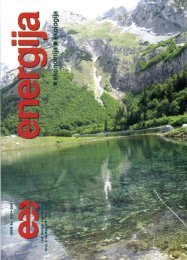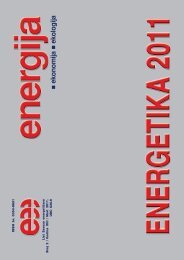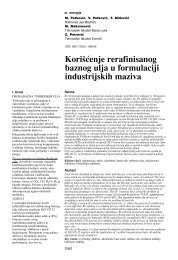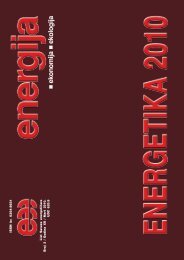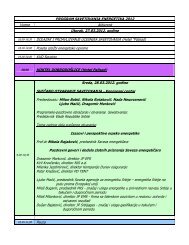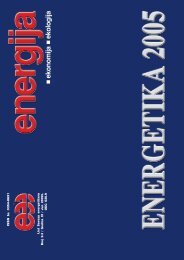ekonomija
2009-5
2009-5
- No tags were found...
You also want an ePaper? Increase the reach of your titles
YUMPU automatically turns print PDFs into web optimized ePapers that Google loves.
energijabe roughly as follows: 1 3000 to 3500for the solar panels, 1#500 to#1000for an inverter + shipment + taxes +solar modules mounting and installation.This gives the average investmentprice from 1#4000 to 5000per installed 1 kW of PV power. So,the energy payback time in Serbiancircumstances is at least 12 years. Inother European countries energy paybacktime varies from 6 to10 years,depending on the specific country, usedsolar cell technology, adopted FITs andother conditions.Over the last few years the solar PVindustry has seen a huge increase indemand. In 2008, worldwide moduleproduction increased 80% on theprevious year. As a result of the globaleconomic slowdown in 2009, pricesare now at an all time low. Marketresearchers found that the mean costof installed PV dropped 3.6% annuallyfrom 1998 through 2008, with adecline of 4.6% from 2007 to 2008.Some PV prices have dropped as muchas 35% in the last two years, which ismaking it tough for manufacturers tosurvive. Under present conditions itseems likely that another 30% may failin 2011, and another 20% in 2012.As a conclusion, the beginning of2010. seems to be not the best momentto invest in solar PV power stationin Serbia. Realistically, the energypayback time is well above 12 (guaranteed)years, and significant solar modulesdecline in pricing can be almostcertainly expected over the course ofthe year.7. Educational IssuesIn spite of the existence of numerousproven and factual information aboutPV solar cells and systems in scientificand technical journals, with conferences,exhibitions, fairs, internet sitesproviding specific information, thereis the opposition constantly attemptingto give false or negative informationabout PV technology. False informationis mainly about PV cell andmodule costs, their destroyable effectson the environment, etc.As an example we could rewrite a consumercomment on the open-site www.energija.wordpress.com/ appeared on23. Dec. 2009, [25], just after mediaannounced the introduction the newgovernment policy, who concludedthe next: “Congratulation for movingalong with FIT initiatives! However,the cheapest offer for the investmentin 100 kW solar power station I’ve arrangedduring a day with the Chinesecompany with total investment costof $2,3 billion! Thus, pay-back timewould be about 36 years, so where isthe interest and the gain with 1 0.23/kWh FIT then?”. The disappointmentof the uninformed costumer can beunderstood, and his comment, albeitfalse, as well. However, no-one havemade any correction on the site so far,this can not be understood. Havingin mind that the false information arespreading much faster then the trueone, a costumer willing to invest inthe photovoltaic system will run outforever. This typical example can beexplained with widespread in Serbiavery-poor educational level in the field.The investment price from $23.000,per installed 1kW of PV solar moduleis really too much, even if Chinesesteal the show!It is very important to provide the truescientific and comparable informationabout PV cells and systems. Therefore,the PV (as an every new technology) isan educational issue. The broad educationalcampaign has to be launched inSerbia, from basic schools to enteringnew study programs and modules atthe University levels. Serbia has tointroduce research facilities, trainingactivities and the dissemination ofinformation about renewable energy.In addition, the number of publishedpapers about PV cells and systems inenergy sector specialized domesticjournals and conferences is pretty low,and has to be increased, no matter -with review, engineering or scientificarticle character. A primal objective ofthis paper is to contribute in that sense.Republic of Serbia is a founder memberof the International RenewableEnergy Agency (IRENA), an intergovernmentalorganisation for promotingthe adoption of renewable energyworldwide. IRENA was officiallyestablished in Bonn, Germany, on 26.January 2009. Up to the end of 2009.,137 states and the European Unionsigned the Statute of the Agency;amongst them are 46 African, 36 European,32 Asian, 14 American and 9Australia/Oceania States. IRENA aimsto facilitate renewable energy technologytransfer and provide experiencefor practical applications and policies.Moreover, the Agency intends to facilitateaccess to all relevant information,including reliable data on the potentialsfor renewable energy, best practices,effective financial mechanisms, andstate-of-the-art technological expertise.In IRENA Memorandum, [26, pp.10],it is stated:It is imperative that every nation in theinternational community:[065]• create research and developmentfacilities;• begin using a wide range of solarenergy technologies, in order tokeep pace with new technologicaldevelopments;• promote the education of scientistsand technicians and increase publicawareness as the basis for increasingself-suffi cient production anduse of Renewable Energy and energyeffi ciency methods;• move quickly to introduce RenewableEnergy technologies.Bridging development gaps andreducing defi cits in the availabilityof information is a crucial global,environmental, economic and politicalissue. ...Those IRENA’s recommendationsclearly emphasized the role of theresearch, education and true informationpolicy in the international andnational frameworks in promoting andintroducing new technology for usingrenewable energy, the role which isparticularly important to developingand transitional countries.ConclusionSolar energy as a source of the renewableenergy has vast potential and it isthe challenge facing the world’s energyfuture. Insufficient awareness of theopportunities for the solar energy maybe an obstacle which can significantlylimit and delayed its use. PV electricityis expensive at the moment, but this isjust a transitory situation, one has tobe educated, trained and prepared forthe future almost certain scenario of itsfavourable use and exploitation. Thegoal could be achieved primarily withsteady as you go positive governmentpolitics in the renewable energy sector,broad and systematic costumers andengineer’s education and extensivefurther support in this field. The aimof this paper is to contribute on theincrease of the public and professionalawareness as the basis for increasingproduction and use of PV solar energy.References[1] A. V. Da Rosa, Fundamentals ofRenewable Energy Processes, 2 ndedition, Academic Press, ElsevierInc., 2009.[2] A. Goetzberger and V. U. Hoffmann,Photovoltaic Solar EnergyGeneration, Springer-Verlag 2005.



